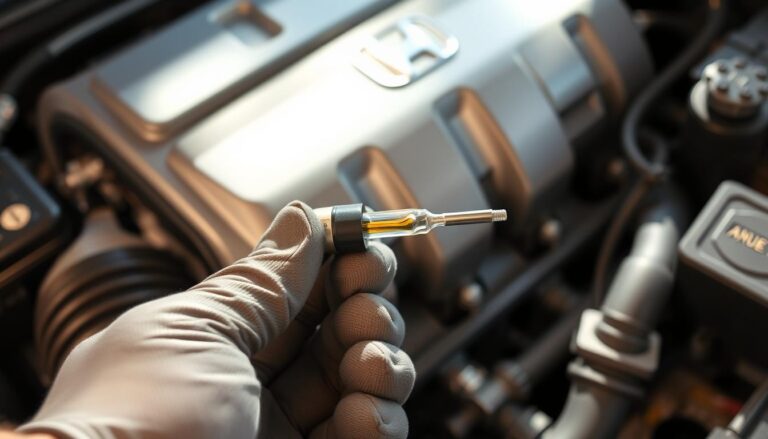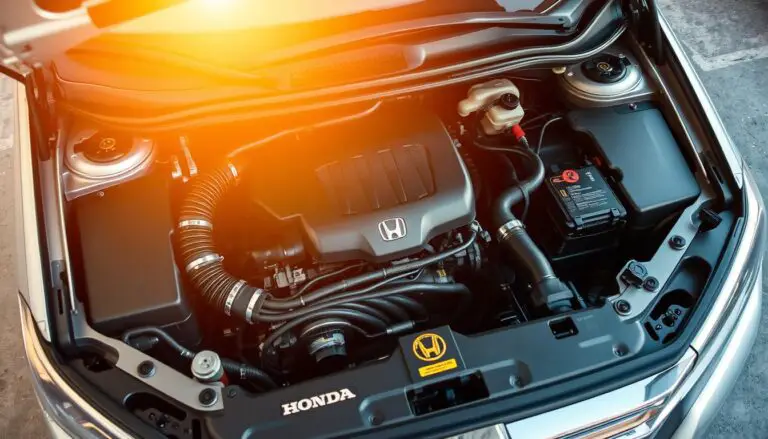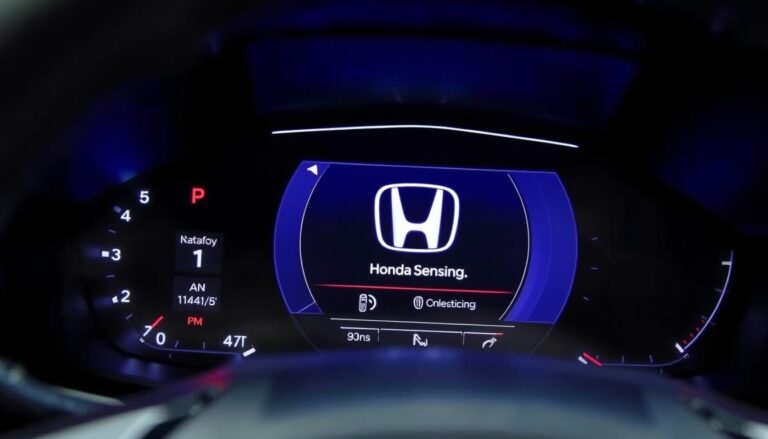Unusual sounds emanating from your vehicle can be a cause for concern, especially when you’re on the road. The Honda CRV is a reliable SUV, but like any other vehicle, it can develop issues that manifest as noise while driving.
Diagnosing the source of the noise is crucial to ensuring your safety and the longevity of your vehicle. Whether it’s a minor issue or a sign of a more significant problem, understanding the cause is the first step towards a solution.
This article aims to guide you through the process of identifying and fixing common noises in your Honda CRV, helping you to maintain its performance and comfort.
Key Takeaways
- Common sources of noise in Honda CRVs
- Steps to diagnose the issue
- Potential fixes for different types of noises
- Importance of regular vehicle maintenance
- When to seek professional help
Common Noise Issues in Honda CRVs
As a Honda CRV owner, you’re likely to encounter various noises at some point, and knowing what they signify is vital. Unusual sounds can indicate potential problems that, if left unaddressed, might lead to more severe issues.
Types of Noises and Their Significance
Different noises can signal various problems. For instance, a grinding noise when braking might indicate worn brake pads, while a whining noise during acceleration could suggest issues with the transmission or a failing bearing.
Model-Specific Noise Problems (2007-2022)
Certain model years of the Honda CRV are prone to specific noise issues. For example, some 2012-2015 models may experience a rattling noise from the dashboard area due to loose trim pieces.
| Model Year | Common Noise Issue | Possible Cause |
|---|---|---|
| 2007-2009 | Clunking noise when turning | Worn steering rack |
| 2012-2015 | Rattling from dashboard | Loose trim pieces |
| 2017-2022 | Whining noise during acceleration | Transmission or bearing issue |
Safety Implications of Unusual Sounds
Ignoring unusual noises can lead to safety hazards. For instance, a failing suspension component can cause loss of control while driving. Prompt diagnosis and repair are crucial for maintaining vehicle safety and preventing costly repairs down the line.
Identifying Honda CRV Noise When Driving
Diagnosing the source of unusual noises in your Honda CRV is crucial for effective CRV noise repair. To start, it’s essential to gather information about the noise.
When and Where the Noise Occurs
Noting when the noise happens is vital. Is it during acceleration, braking, or when driving over bumps? Identifying the conditions under which the noise occurs can help narrow down its source.
Characteristics of Different Noises
The type of noise can also provide clues. For instance, a grinding noise might indicate worn-out bearings, while a clunking sound could suggest loose or worn suspension components.
Basic Diagnostic Techniques
Basic diagnostic techniques include listening carefully to the noise, checking for any recent maintenance or repairs, and inspecting the vehicle’s underside for any signs of wear or damage. By following these steps, you can better understand the cause of the noise and take the first steps towards effective CRV noise repair.
Fixing Engine-Related Noises
Engine-related noises in your Honda CRV can be a source of frustration and concern. These sounds can indicate potential issues that, if left unaddressed, may lead to more significant problems. Understanding the source of these noises is the first step towards resolving them.
Rattling or Ticking Sounds from the Engine
Rattling or ticking sounds often point to issues with the engine’s internal components. Common causes include low oil pressure, worn-out lifters, or loose components. Regular Honda CRV maintenance can help prevent these issues.
To diagnose, check the oil level and condition. If the oil is dirty or at a low level, change it and see if the noise persists. If the problem continues, it may be necessary to consult a professional mechanic.

Whining or Squealing from Belts and Pulleys
Whining or squealing noises often relate to the serpentine belt or other belts and pulleys in your Honda CRV. Worn-out belts, misaligned pulleys, or worn bearings can cause these sounds. Inspecting the belts for cracks or wear and checking the tension can help identify the issue.
Knocking or Clunking Under the Hood
Knocking or clunking sounds can be more alarming and may indicate serious engine problems, such as rod knock or piston slap. These issues require immediate attention from a qualified mechanic to prevent further damage.
DIY Repair Steps for Common Engine Noises
For minor issues, DIY repairs can be a cost-effective solution. Here are some steps you can take:
- Check and maintain the proper oil level and condition.
- Inspect belts and pulleys for wear and replace as needed.
- Tighten any loose components.
By following these steps and staying on top of Honda CRV maintenance, you can resolve many common engine-related noises and keep your vehicle running smoothly.
Resolving Suspension and Steering Issues
Suspension and steering problems often manifest as noises in Honda CRVs, requiring timely diagnosis. These noises can be due to various factors, including wear and tear on suspension components or misalignment in the steering system.
Strut and Shock Absorber Noise Repairs
Worn-out struts and shock absorbers are common sources of noise in Honda CRVs. Replacing these components can significantly reduce noise. It’s essential to inspect the struts and shock absorbers regularly for signs of wear.
Ball Joint and Tie Rod Maintenance
Ball joints and tie rods are critical components of the steering system. Regular lubrication and inspection can prevent noise caused by worn-out ball joints and tie rods. Replacement is necessary if they are damaged.
Control Arm and Bushing Replacement
Control arms and bushings play a crucial role in the suspension system. Worn-out bushings can cause clunking or creaking noises. Replacing control arms and bushings can resolve these issues.
Tools Needed for Suspension Repairs
The following tools are necessary for suspension repairs: ball joint separator, tie rod end remover, bushing removal tools, and a torque wrench.
| Tool | Purpose |
|---|---|
| Ball Joint Separator | Separating ball joints from the steering knuckle |
| Tie Rod End Remover | Removing tie rod ends from the steering knuckle |
| Bushing Removal Tools | Replacing worn-out bushings |
| Torque Wrench | Tightening bolts to the correct torque specification |

By addressing suspension and steering issues promptly, Honda CRV owners can prevent further damage and ensure a smoother ride.
Solving Transmission and Drivetrain Noises
When your Honda CRV starts making unusual noises from the transmission or drivetrain, it’s a sign that something is amiss and needs fixing. These noises can range from whining and grinding to clunking sounds, each indicating different potential issues.
CVT Transmission Whine Solutions
The Continuously Variable Transmission (CVT) in Honda CRVs can sometimes produce a whining noise, often due to worn-out or low transmission fluid levels. Checking and maintaining the transmission fluid at the recommended levels can resolve this issue. If the whine persists, it may indicate a more serious problem requiring professional inspection.
Differential and Transfer Case Maintenance
Differential and transfer case noises are typically characterized by whining or grinding sounds, especially when turning or accelerating. Regular maintenance, including fluid checks and replacements, can prevent these issues. If the noise continues, inspecting the differential and transfer case for wear or damage is necessary.
Drive Shaft and CV Joint Repairs
Clunking or vibrating noises can be attributed to issues with the drive shaft or CV joints. Inspecting these components for any signs of wear or damage and replacing them if necessary can resolve the problem.
Fluid Replacement Procedures
Fluid replacement is a critical maintenance task. For Honda CRVs, using the correct type of fluid as specified by the manufacturer is crucial. The process involves draining the old fluid and replacing it with new fluid, a task that can be performed at home or by a professional.
| Component | Common Noise | Solution |
|---|---|---|
| CVT Transmission | Whining | Check and maintain transmission fluid |
| Differential/Transfer Case | Whining/Grinding | Regular fluid checks and replacements |
| Drive Shaft/CV Joints | Clunking/Vibrating | Inspect and replace worn components |
Preventative Maintenance to Avoid Future Noises
Honda CRV owners can avoid future noise issues by prioritizing preventative maintenance. Regular checks and timely repairs can significantly reduce the likelihood of developing annoying sounds while driving.
Regular Inspection Schedule
Establishing a regular inspection schedule is crucial. This includes checking the vehicle’s suspension, steering, and drivetrain components for signs of wear. Regular inspections can help identify potential issues before they become major problems.
Proper Lubrication Practices
Proper lubrication is essential for the smooth operation of your Honda CRV’s parts. Ensuring that all moving parts are well-lubricated can prevent friction-related noises. Regularly check and top off fluids as needed.
Early Warning Signs to Watch For
Being aware of early warning signs can help prevent minor issues from becoming major repairs. Listen for unusual noises, and address them promptly. Early detection is key to maintaining your vehicle’s health. By following these preventative maintenance tips, Honda CRV owners can enjoy a quieter and more reliable driving experience.
Maintaining a Quiet Ride: The Importance of CRV Noise Repair and Honda CRV Maintenance
Diagnosing and fixing unusual noises in your Honda CRV is crucial for a comfortable and safe driving experience. By understanding the common noise issues, identifying the source of the problem, and applying the necessary repairs, you can ensure your vehicle remains in optimal condition.
Regular Honda CRV maintenance is key to preventing future noises and potential damage. By following a routine inspection schedule, practicing proper lubrication, and being aware of early warning signs, you can keep your CRV running smoothly and quietly.
Whether it’s addressing engine-related noises, suspension and steering issues, or transmission and drivetrain problems, taking proactive steps towards CRV noise repair can save you from costly repairs down the line. Stay on top of your vehicle’s maintenance needs to enjoy a quieter ride and extend the lifespan of your Honda CRV.
FAQ
What are the most common noises in Honda CRVs?
Common noises in Honda CRVs include rattling or ticking sounds from the engine, whining or squealing from belts and pulleys, and clunking or knocking under the hood, as well as suspension and steering noises.
How do I diagnose the source of a noise in my Honda CRV?
To diagnose the source of a noise, identify when and where the noise occurs, note the characteristics of the noise, and use basic diagnostic techniques such as listening and inspecting the vehicle.
Can I fix engine-related noises myself?
Yes, some engine-related noises can be fixed using DIY repair steps, such as replacing worn-out belts and pulleys or addressing loose or damaged engine components.
What are the safety implications of ignoring unusual sounds in my Honda CRV?
Ignoring unusual sounds can lead to safety issues, as they can be indicative of underlying problems that may cause further damage or even lead to accidents if left unaddressed.
How often should I inspect my Honda CRV to prevent future noises?
Regular inspections should be performed according to a scheduled maintenance plan, which includes checking for worn-out or damaged parts, proper lubrication, and addressing any issues promptly.
What are the benefits of proper lubrication practices for my Honda CRV?
Proper lubrication practices can help prevent wear and tear on moving parts, reduce friction, and minimize the risk of noise development, ultimately extending the lifespan of the vehicle.
Can I prevent transmission and drivetrain noises in my Honda CRV?
Yes, regular maintenance, such as fluid replacement and inspections, can help prevent transmission and drivetrain noises, and addressing any issues promptly can minimize the risk of further damage.
What are the early warning signs that my Honda CRV may need repair?
Early warning signs include unusual noises, vibrations, or changes in performance, which should be investigated and addressed promptly to prevent further damage and potential safety issues.


